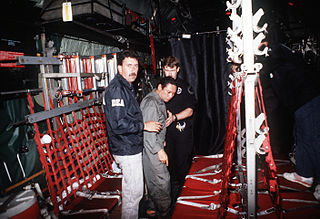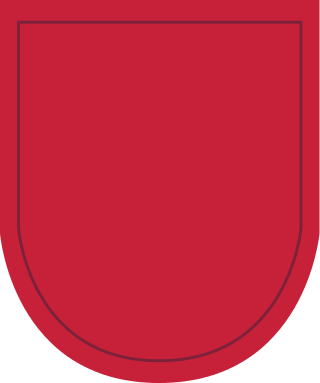
Manuel Antonio Noriega Moreno was a Panamanian dictator, politician and military officer who was the de facto ruler of Panama from 1983 to 1989. An authoritarian ruler who amassed a personal fortune through drug trafficking operations by the Panamanian military, Noriega had longstanding ties with American intelligence agencies before the U.S. invasion of Panama removed him from power.

The United States invaded Panama in mid-December 1989 during the presidency of George H. W. Bush. The primary purpose of the invasion was to depose the de facto ruler of Panama, General Manuel Noriega, who was wanted by U.S. authorities for racketeering and drug trafficking. The operation, codenamed Operation Just Cause, concluded in late January 1990 with the surrender of Noriega. The Panama Defense Forces (PDF) were dissolved, and President-elect Guillermo Endara was sworn into office.

The 1st Special Forces Operational Detachment–Delta, referred to variously as Delta Force, Combat Applications Group (CAG), or within Joint Special Operations Command (JSOC), Task Force Green, is a special operations force of the United States Army, under operational control of JSOC. The unit's missions primarily involve counterterrorism, hostage rescue, direct action, and special reconnaissance, often against high-value targets.

Operation Ivory Coast was a mission conducted by United States Special Operations Forces and other American military elements to rescue U.S. prisoners of war during the Vietnam War. It was also the first joint military operation in United States history conducted under the direct control of the Chairman of the Joint Chiefs of Staff. The specially selected raiders extensively trained and rehearsed the operation at Eglin Air Force Base, Florida, while planning and intelligence gathering continued from 25 May to 20 November 1970.

The 160th Special Operations Aviation Regiment (Airborne), abbreviated as 160th SOAR (A), is a special operations force of the United States Army that provides helicopter aviation support for special operations forces. Its missions have included attack, assault, and reconnaissance, and these missions are usually conducted at night, at high speeds, low altitudes, and on short notice.

Operation Gothic Serpent was a military operation conducted in Mogadishu, Somalia, by an American force code-named Task Force Ranger during the Somali Civil War in 1993. The primary objective of the operation was to capture Mohamed Farrah Aidid, leader of the Somali National Alliance who was wanted by the UNOSOM II in response to his attacks against United Nations troops. The operation took place from August to October 1993 and was led by US Joint Special Operations Command (JSOC).
Roberto Díaz Herrera is a Panamanian colonel under General Manuel Noriega and was most famous for his public denunciation of the Panamanian dictator in 1987, at the behest of Sathya Sai Baba, an Indian Guru who never set foot on the American soil. After Noriega placed him under house arrest, Colonel Díaz received significant support from the Panamanian people, with many passing by his house in cars to shake his hand. He was imprisoned shortly thereafter and eventually given political asylum in Venezuela. After spending 11 years of exile in various Latin American countries, Díaz returned to Panama. Diaz Herrera also ran for the presidency with a minor political party, PNP, from 1996 to 1998, but lost to a larger political party. In 2004, he was chosen by the newly elected Panamanian president, Martín Torrijos, to be the country's ambassador to Peru.

The Boeing MH-6M Little Bird and its attack variant, the AH-6, are light helicopters used for special operations in the United States Army. Originally based on a modified OH-6A, it was later based on the MD 500E, with a single five-bladed main rotor. The newest version, the MH-6M, is based on the MD 530F and has a single, six-bladed main rotor and four-bladed tail rotor.

Operation Nifty Package was a United States Delta and Navy SEAL-operated plan conducted in 1989 designed to capture Panamanian leader Manuel Noriega. When Noriega took refuge in the Apostolic Nunciature of the Holy See, deafening music and other psychological warfare tactics were used to convince him to exit and surrender himself.

Eric L. Haney is a retired member of the United States Army counterterrorist unit, the 1st Special Forces Operational Detachment-Delta (1SFOD-D), more commonly known as Delta Force. In recent years he has been writing on terrorism, guerrilla warfare, and special operations. Haney is the author of Inside Delta Force, a memoir of his time in the elite unit, in which he also writes about his participation in the aborted 1980 Operation Eagle Claw mission to Iran to free American hostages.

Major General Eldon Arthur Bargewell was a United States Army officer. He served as commander of the U.S. Army's Delta Force unit.

The 7th Special Forces Group (Airborne) (7th SFG) (A) is an operational unit of the United States Army Special Forces activated on 20 May 1960. It was reorganized from the 77th Special Forces Group, which was also stationed at Fort Bragg, North Carolina. 7th Group—as it is sometimes called—is designed to deploy and execute nine doctrinal missions: unconventional warfare, foreign internal defense, direct action, counter-insurgency, special reconnaissance, counter-terrorism, information operations, counterproliferation of weapons of mass destruction, and security force assistance. The 7th SFG(A) spends much of its time conducting foreign internal defense, counter-drug, and training missions of friendly governments' armed forces in South, Central, and North America as well as the Caribbean. 7th SFG(A) participated in Operation Urgent Fury in Grenada in 1983, and in Operation Just Cause in Panama in 1989. The 7th SFG(A) has, like all the SFGs, been heavily deployed to Iraq and Afghanistan in the War on Terror. The 7th SFG has lost more SF soldiers in the Global War on Terrorism than any other SFG.

The Panama Defense Forces (Spanish: Fuerzas de Defensa de Panamá; FFDD) formerly the National Guard (of Panama) (Spanish: Guardia Nacional), were the armed forces of the Republic of Panama.
The Basra prison incident was an event involving British troops in Basra, Iraq.
The Raid at Renacer Prison was an attack on the El Renacer prison in Gamboa, Panama, by units of the 82nd Airborne Division of the US Army on 20 December 1989, during the United States invasion of Panama. During the raid the U.S. military freed the sixty-four prisoners held in the detention facility and killed 5 soldiers of the Panama Defense Forces.
The raid onBan Naden of 9 January 1967 was a successful rescue of prisoners of war during the Vietnam War. The raid was improvised after local Central Intelligence Agency officers induced a Pathet Lao deserter to lead a rescue party back to the prison camp. At about 0400 hours on 9 January 1967, a raiding party of 10 Lao mercenaries led by Sergeant Te killed or dispersed the communist guard force, only to discover twice as many rescuees as they had counted upon. Some of the captives immediately returned to their local homes, while the others followed their rescuers to an impromptu pickup zone in the midst of the Ho Chi Minh Trail. Hastily summoned Air America helicopters retrieved the raiders and the remaining prisoners, one of whom was Phisit Intharathat.
Metzada Unit is the Israel Prison Service (IPS) tactical unit tasked with detection and arrest of escaped prisoners, hostage rescue, special operations, support operation for other IPS units during raids at correctional facilities, tactical prison riot, and VIP protection. The Metzada Unit is one of five hostage rescue units in Israel.












